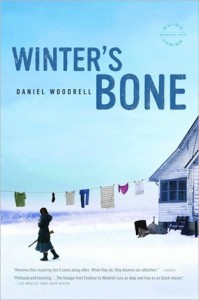Woodrell, Daniel (2006). Winter’s Bone. New York: Hachette Book Group
When I saw the movie several years ago, I thought the cinematography was overdone. Every scene was filled with squalor, so much so that it created an unnecessarily dark mood and actually verged on non-believable. Now I know the movie was just being faithful to the novel.
The mood is so consistently “down” in this book, it becomes tiresome. A poor, rural family in the Ozark mountains of Arkansas struggles to survive. A teenage girl, Ree, is the protagonist. The father, a meth cooker and dealer, has disappeared. The mother is mentally ill, a near-vegetable. Ree cares for two young boys. She struggles to find food and clothing. She shoots squirrels for dinner. She chops wood in the snow. She hangs laundry to dry on lines across the kitchen. It’s dark, hungry, cold, sore, wet, and hopeless on every page, and it never lets up. Maybe that’s how it is in that actual society, but that’s hardly artistic justification for using such a monochromatic mood.
The people in her neck of the woods are family clans, some close, others less so. All seem dimwitted, uneducated, and self-obsessed. Most of the men are involved in cooking, selling, and taking methamphetamines. They drink smoke, swear, bluster, do drugs, mistreat women, neglect children, ignore the law, and drive rattle-trap trucks with shotguns in them. Characterization of the social environment is unrelentingly depressing. Why? What is the artistic purpose?
The basic story is that Ree’s missing father has put up the house as collateral against bail bond, and must appear in court in one week or the house will be lost to the bondsman. The story is structured as a series of episodes wherein Ree treks through snowy woods to the neighbors’ places to find her father before it’s too late. Nobody knows anything but we get to meet the strange, mean, ugly, and weird people who live near her “hollow.” Will she save the farm? Of course she will, and we always knew she would, but that was just an arbitrary scaffold the author hung his words on.
The writing has several strengths. One is close observation: just the right color of the melting snow, just the right smell of smoky air, just the right scars on a face. The observational detail is perfect. Another strength is the dialog and its accompanying Ozark dialect, slang, and idioms, all of which are very authentic-sounding and interesting.
Offsetting those strengths, the writing is straightforwardly descriptive, not particularly poetic or insightful, except that it was fascinating to note how many human body products were described: all of them. Dialog, while rhythmically musical, is mostly the quotidian back and forth of stupid people discussing their tiny lives.
Characters are revealed by their actions and words, but they are revealed to be dim bulbs without much awareness of self or world. The only virtue highlighted in this bleak tale is that in time of great trouble, eventually family will help you. Even non-family might, if the community is small and ingrown enough. I’m not sure if that’s a good enough reward for such a dark journey.

